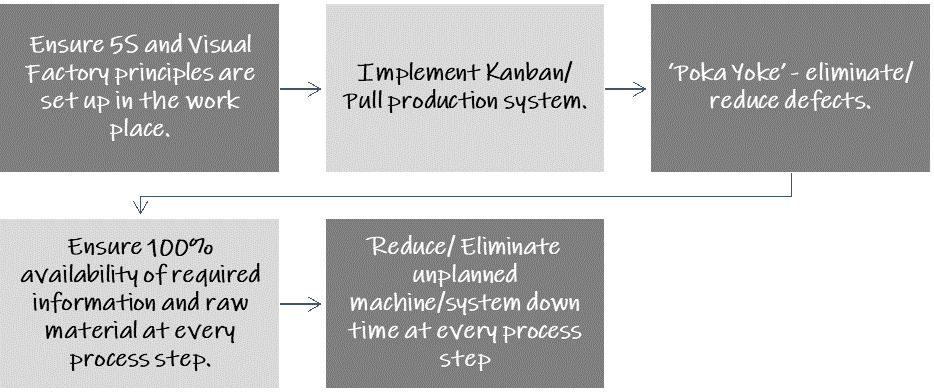Single piece flow (SPF) is a Lean tool, and it means moving one unit of work between the steps of an operation at a time. Based on experience, here are the following benefits you will gain from carrying out SPF:
- It makes the problems obvious: In a single piece flow, only one piece moves between the steps. Therefore, the entire line stops if even one operation halts! This makes it easy to identify the problem with a single glance. Soon after, there is an immediate response to fix the problem once the line has stopped.
- It improves quality: By focusing on one piece at a time, single piece flow guarantees quality improvement.

- It improves efficiency: In the case of single piece flow, I have personally tested this improvement in efficiency in many places. SPF increases efficiency by removing the ‘inventory veil’, thereby making the problems visible. Therefore, the response time to fix the problem is drastically reduced because the whole line stops. Additionally, the layout usually changes to suit a single piece flow. Hence, material movement is minimized as sequential steps are made to be next to one another as far as possible.

- It improves productivity: Single piece flow can boost productivity. If two machines are kept close to one another, keeping in mind a careful study of cycle time and training, one operator can handle multiple machines. This set up of one operator handling multiple machines is not recommended until good systems such as Poka-Yoke, visual factory, semi/ and full automation are in place.

How does a Single Piece Flow Work?

Single piece flow will disclose problems. In the beginning, don’t get surprised if the output decreases instead of increasing. This is because all the problems that hid behind inventory are now exposed. Additionally, note that the response time to fix them will be high. The reason for this is that previously, as inventory was present, the maintenance personnel would fix problems off-site.
Additionally, a lack of knowledge, skills, and experience regarding the identification of the root cause of problems only makes matters worse! Many companies give up on single piece flow after facing just one hiccup. They tend to blame the technique! However, it is often our implementation of the technique that is flawed. Therefore, if something isn’t right, go back and check!

How to apply Single Piece Flow?
Preliminary needs:
Find below the preliminary needs to carry out a single piece flow. Once the supporting systems are in place, you can consider setting up an SPF:

Figure 1 – Preparations for implementing SPF
The Next Steps to Carrying Out Single Piece Flow:
- First off, do not carry out SPF if there are quality issues and machine breakdowns.
- Secondly, make sure that you define takt time first, and use load levelling (Heijunka) if required.
- Thirdly, design a cell for balancing cycle time to takt time.
- Fourthly, define the number of pieces that should flow between each step. It needn’t be a single piece between the steps. Hence, use an economic batch size if necessary.
- Fifthly, ensure that raw material, measurement gauge, and information (such as drawings and work instruction) are made available near the point of use. Furthermore, make sure that the layout suits the purpose.
- Sixthly, use skilled operators. If needed, train new operators.
- Lastly, run a pilot first. Consequently, note down the barriers to flow, if any, and identify the Kaizens to overcome them. Thereafter, run a pilot again. Continue pilots till you achieve the needed results. Once a pilot is successful, carry out SPF in a full-fledged manner!

Figure 2 – Steps to implement SPF
